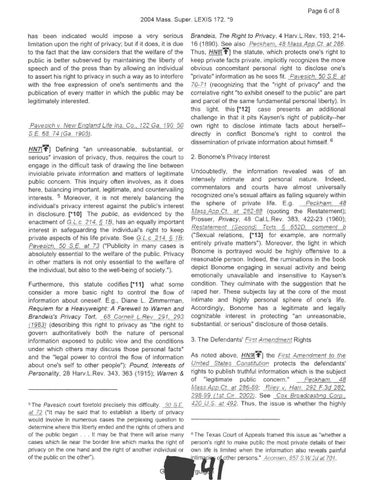Page 6 of 8 2004 Mass. Super. LEXIS 172. *9 has been indicated would impose a very serious limitation upon the right of privacy; but if it does, it is due to the fact that the law considers that the welfare of the public is better subserved by maintaining the liberty of speech and of the press than by allowing an individual to assert his right to privacy in such a way as to interfere with the free expression of one's sentiments and the publication of every matter in which the public may be legitimately interested.
Pavesich v. Ne w England Life Ins. Co., ·122 Ga. 'I 90 50 SE 68. 74 (Ga . 1905).
HNZ[-,,] Defining "an unreasonable, substantial, or serious" invasion of privacy, thus. requires the court to engage in the difficult task of drawing the line between inviolable private information and matters of legitimate public concern. This inquiry often involves, as it does here, balancing important, legitimate, and countervailing interests. 5 Moreover, it is not merely balancing the individual's privacy interest against the public's interest in disclosure . ["10) The public, as evidenced by the enactment of G.L.c .. 214,_ §_) B, has an equally important interest in safeguarding the individual's right to keep private aspects of his life private. See _G.L.c 214, _§ __18; Pavesich 50 S.E. at 73 ("Publicity in many cases is absolutely essential to the welfare of the public. Privacy in other matters is not only essential to the welfare of the individual, but also to the well-being of society."). Furthermore, this statute codifies [*11] what some consider a more basic right to control the flow of information about oneself. E.g ., Diane L. Zimmerman, Requiem for a Heavyweight: A Farewell to Warren and Brandeis's Privacy Tori, __ 68 Comeli L.Rev. 291. 293 {JJB::U, (describing this right to privacy as "the right to govern authoritatively both the nature of personal information exposed to public view and the conditions under which others may discuss those personal facts" and the "legal power to control the flow of information about one's self to other people"): Pound. Interests of Personality, 28 Harv.L.Rev. 343 , 363 (1915); Warren &
5 The Pavesich court foretold precisely this difficulty. SO SE §L 72 ("It may be said that to establish a liberty of privacy
would involve in numerous cases the perplexing question to determine where this liberty ended and the rights of others and of the public began .. . It may be that there will arise many cases which lie near the border line which marks the right of privacy on the one hand and the right of another individual or of the public on the other").
Brandeis. The Right to Privacy, 4 Harv.L.Rev. 193, 21416 (1890). ~e also P~f.lsh?.m,__1:_§.M!i~§AJ2P., 9.f-__§LZJ3.§. Thus, HNB[-f] the statute, which protects one's right to keep private facts private. implicitly recognizes the more obvious concomitant personal right to disclose one's "private" information as he sees fit. Pavesich, 50 S.E. at 79:U (recognizing that the "right of privacy" and the correlative right "to exhibit oneself to the public" are part and parcel of the same fundamental personal liberty) . In this light, this r121 case presents an additional challenge in that it pits Kaysen's right of publicity--her own right to disclose intimate facts about herself-directly in conflict Bonome's right to control the dissemination of private information about himself. 6
2. Bonome's Privacy Interest Undoubtedly, the information revealed was of an intensely intimate and personal nature . Indeed, commentators and courts have almost universally recognized one's sexual affairs as falling squarely within the sphere of private life. E.g. Peckham. 48 Mass. Acp. Ct. at 282- 88 (quoting the Restatement); Prosser. Privacy, 48 Cal.L.Rev. 383, 422-23 (1960); Restatement (Second) Tort.s § 652D. comment b ("Sexual relations , [*13] for example , are normally entirely private matters"). Moreover, the light in which Bonome is portrayed would be highly offensive to a reasonable person . Indeed, the ruminations in the book depict Banome engaging in sexual activity and being emotionally unavailable and insensitive to Kaysen's condition . They culminate with the suggestion that he raped her. These subjects lay at the core of the most intimate and highly personal sphere of one's life. Accordingly, Banome has a legitimate and legally cognizable interest in protecting "an unreasonable, substantial. or serious" disclosure of those details.
3. The Defendants' FirstA mendme nt Rights As noted above, HN9['i'J the First Amendment to the United States Constitution protects the defendants' rights to publish truthful information which is the subject of "legitimate public concern." ,0 eckham, 48 Ma ss App. Ct. at 2{36- 8~; Rilev v. f-farr. 292 F.3d 282, 298-99 ( 1st Cir 20021. See Cox Broadcasting Corp .. 420 U S. at 492. Thus, the issue is whether the highly
6
The Texas Court of Appeals framed this issue as "whether a person's right to make public the most private details of their own life is limited when the information also reveals painful
·:'J;J lother
persons." ,4@!l§Y1!,. §?Z~.11UJ at 7OI.




